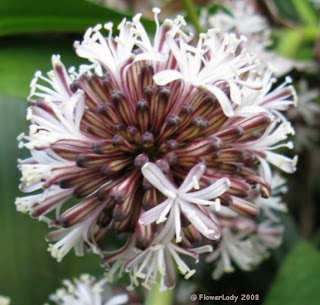Good morning everyone.
This post came about because this plant is in full bloom right now,
blooming at night and the scent is so strong
I can hardly stand it and I love nice strong scents.
This one is a bit overwhelming with so many blossoms though.
So, I took some pictures and found some info to share here.
This post came about because this plant is in full bloom right now,
blooming at night and the scent is so strong
I can hardly stand it and I love nice strong scents.
This one is a bit overwhelming with so many blossoms though.
So, I took some pictures and found some info to share here.
******
http://en.wikipedia.org/wiki/Corn_Plant
Dracaena fragrans (Corn Plant, Cornstalk Dracaena)
is a flowering plant species in the family Ruscaceae,
that resembles a corn stalk in habitus.
It is native to West Africa, Tanzania, and Zambia.
Dracaena fragrans has rosettes of glossy, green leaves, broadly striped
and banded with light green and yellow down the center.
It is a slow growing pole shrub
and the leaves can reach up to
3 feet (1 m) long by 4 inches (10 cm) wide.
When plants are grown in the ground,
they can reach about 20 foot tall (over 6 m)
but their growth is limited when they are potted.
Cornstalk Dracaen has white flowers that are highly fragrant,
hence the specific name fragans.
They are popular with insects,
and in the Neotropics get rarely visited by a few generalist hummingbird species
like the Sapphire-spangled Emerald.
Dracaena fragrans is propagated by cutting off segments of old canes
so that they are 3-8 inches long.
These are allowed to dry off and inserted into moist sand
until they have rooted and new growth comes from old leaf scars.
Fragrans can be either grown as a low shrub form,
by rooting tip cuttings,
or a tree form, by rooting mature canes.
The 'Massangeana" variety is the most popular,
due to its dramatic yellow variegation running down the center of its leaves.
The temperature requirements for fragrans is a comfortable 75 degrees
and the water requirements are low.
Dracaenas are one of the plants used in the NASA Clean Air Study
and has shown to help remove Formaldehyde.
Dracaenas have wide leaves that do accumulate dust.
Wipe leaves regularly with a damp cloth to remove dust.
Although most Dracaenas have few problems with pest,
occasionally mealy bug and scale can attack the plant.
is a flowering plant species in the family Ruscaceae,
that resembles a corn stalk in habitus.
It is native to West Africa, Tanzania, and Zambia.
Dracaena fragrans has rosettes of glossy, green leaves, broadly striped
and banded with light green and yellow down the center.
It is a slow growing pole shrub
and the leaves can reach up to
3 feet (1 m) long by 4 inches (10 cm) wide.
When plants are grown in the ground,
they can reach about 20 foot tall (over 6 m)
but their growth is limited when they are potted.
Cornstalk Dracaen has white flowers that are highly fragrant,
hence the specific name fragans.
They are popular with insects,
and in the Neotropics get rarely visited by a few generalist hummingbird species
like the Sapphire-spangled Emerald.
Dracaena fragrans is propagated by cutting off segments of old canes
so that they are 3-8 inches long.
These are allowed to dry off and inserted into moist sand
until they have rooted and new growth comes from old leaf scars.
Fragrans can be either grown as a low shrub form,
by rooting tip cuttings,
or a tree form, by rooting mature canes.
The 'Massangeana" variety is the most popular,
due to its dramatic yellow variegation running down the center of its leaves.
The temperature requirements for fragrans is a comfortable 75 degrees
and the water requirements are low.
Dracaenas are one of the plants used in the NASA Clean Air Study
and has shown to help remove Formaldehyde.
Dracaenas have wide leaves that do accumulate dust.
Wipe leaves regularly with a damp cloth to remove dust.
Although most Dracaenas have few problems with pest,
occasionally mealy bug and scale can attack the plant.











No comments:
Post a Comment